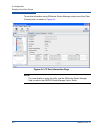
4–Configuration
Connecting iSCSI Hosts to the iSR6200
4-16 ISR651101-00 G
Figure 4-13 shows presenting LUN 3 incorrectly. If an iSCSI host logged into both
VPG0 and VPG1, it would have access to LUN 3 through two virtual port groups.
This is invalid and will lead to serious problems.
Figure 4-13. Incorrectly Presenting LUN 3
Presenting the LUN at different LUN indexes for each VP will confuse the iSCSI
host MPIO software because it will see the same LUN WWLUNID at two different
indexes. This would cause the multipath I/O (MPIO) driver to panic and show a
blue screen. Without an MPIO driver, the system could corrupt data on the LUN,
without crashing—a situation you want to avoid.
Connecting iSCSI Hosts to the iSR6200
Upon logging into a Fibre Channel target WWPN, an iSR6200 blade presents an
iSCSI target to which iSCSI initiators can connect. This target is defined by its
iSCSI qualified name (IQN) string. To correctly connect iSCSI initiators to Fibre
Channel targets through the iSR6200, it is important to understand the
composition of the iSCSI target IQN string.
iSR6200
Storage Array
Blade 1
21:00:00:c0:dd:13:16:44
21:00:00:c0:dd:13:16:45
FC1
FC2
Host Entities
Host Entity 0
21:01:00:c0:dd:13:16:44
21:01:00:c0:dd:13:16:45
Host Entity 1
21:02:00:c0:dd:13:16:44
21:02:00:c0:dd:13:16:45
Host Entity 2
21:03:00:c0:dd:13:16:44
21:03:00:c0:dd:13:16:45
Host Entity 3
LUN 1
LUN 2
LUN 3
LUN 4
LUN 5
21:00:00:c0:dd:13:16:44
21:01:00:c0:dd:13:16:44
21:02:00:c0:dd:13:16:44
21:03:00:c0:dd:13:16:44
21:00:00:c0:dd:13:16:45
21:01:00:c0:dd:13:16:45
21:02:00:c0:dd:13:16:45
21:03:00:c0:dd:13:16:45


















